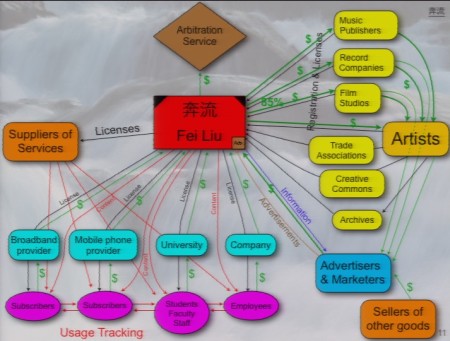Digital Media Exchange: P2P Platform for Free Content
We already mentioned the Digital Media Exchange (DMX) platform when it came to the Canadian Future of Music conference two months ago. Professor William Terry Fisher spoke personally at that conference and spoke about developing the Digital Media Exchange decentralized exchange of audio and video recordings, which will soon begin work in China, Canada and several other countries ( videos and slides of the professor’s presentation ).
The experimental system, known in Canada as Noank Media, broadcasts unprotected multimedia content for free. Users can download as many audio and video files from the Internet, and fees for royalties are collected from Internet providers, universities and owners of other networks that broadcast content. Fees are paid in proportion to the number of views / plays.
As Professor Fisher writes in his book, “Promises to Keep: Technology, Law, and the Future of the Entertainment Industry” ( introduction to PDF ), it all began back in 2000, in the era of Napster. Then a professor in front of an audience of 700 lawyers in Rio de Janeiro gave a lecture on the impact of the Internet on intellectual property laws. He began to talk about Napster and saw the understanding views of the audience. Then the professor asked bluntly: how many of you used Napster? Approximately half of those present in the audience raised their hands. It was the best proof of the crisis of existing intellectual property laws . In the era of the Internet, copyright laws are simply impossible to comply with, they began to contradict elementary logic.
Further in his book, William Fisher describes a possible way out of the situation: the creation of an alternative compensation system ( Chapter 6 in PDF ). The Digital Media Exchange (DMX) project is a natural continuation of the research of Professor Fisher.
')
The DMX Exchange is a peer-to-peer system run by a non-profit cooperative, including rights holders. The DMX technology platform not only distributes content, but also gives users the ability to communicate with each other in blogs and discussion groups, search for information, read and evaluate recommendations, and buy fan attributes. The user community thus becomes a real financial income generator for rights holders, and it’s not at all necessary to sell the content itself.
In the DMX network, any content is distributed absolutely freely: movies, music, television programs, photos, games, documents, etc. No restrictions on distribution, no DRM. In doing so, the DMX system will be fully compatible with existing copyright laws, and representatives of Harvard Law School will oversee its work.
Payment for access to the DMX network is already included in the tariff plans of Internet providers. Thus, the cooperative collects money from the operators and distributes the profit received among the rightholders (85%), and also pays the current expenses of the cooperative.
As Professor Fisher says, the DMX platform has already concluded the first contracts and is beginning to unfold in Canada (called Noank Media), Hong Kong and China (Fei Liu). The specific pattern of DMX work is shown on the slide.

The experimental system, known in Canada as Noank Media, broadcasts unprotected multimedia content for free. Users can download as many audio and video files from the Internet, and fees for royalties are collected from Internet providers, universities and owners of other networks that broadcast content. Fees are paid in proportion to the number of views / plays.
As Professor Fisher writes in his book, “Promises to Keep: Technology, Law, and the Future of the Entertainment Industry” ( introduction to PDF ), it all began back in 2000, in the era of Napster. Then a professor in front of an audience of 700 lawyers in Rio de Janeiro gave a lecture on the impact of the Internet on intellectual property laws. He began to talk about Napster and saw the understanding views of the audience. Then the professor asked bluntly: how many of you used Napster? Approximately half of those present in the audience raised their hands. It was the best proof of the crisis of existing intellectual property laws . In the era of the Internet, copyright laws are simply impossible to comply with, they began to contradict elementary logic.
Further in his book, William Fisher describes a possible way out of the situation: the creation of an alternative compensation system ( Chapter 6 in PDF ). The Digital Media Exchange (DMX) project is a natural continuation of the research of Professor Fisher.
')
The DMX Exchange is a peer-to-peer system run by a non-profit cooperative, including rights holders. The DMX technology platform not only distributes content, but also gives users the ability to communicate with each other in blogs and discussion groups, search for information, read and evaluate recommendations, and buy fan attributes. The user community thus becomes a real financial income generator for rights holders, and it’s not at all necessary to sell the content itself.
In the DMX network, any content is distributed absolutely freely: movies, music, television programs, photos, games, documents, etc. No restrictions on distribution, no DRM. In doing so, the DMX system will be fully compatible with existing copyright laws, and representatives of Harvard Law School will oversee its work.
Payment for access to the DMX network is already included in the tariff plans of Internet providers. Thus, the cooperative collects money from the operators and distributes the profit received among the rightholders (85%), and also pays the current expenses of the cooperative.
As Professor Fisher says, the DMX platform has already concluded the first contracts and is beginning to unfold in Canada (called Noank Media), Hong Kong and China (Fei Liu). The specific pattern of DMX work is shown on the slide.

Source: https://habr.com/ru/post/5000/
All Articles